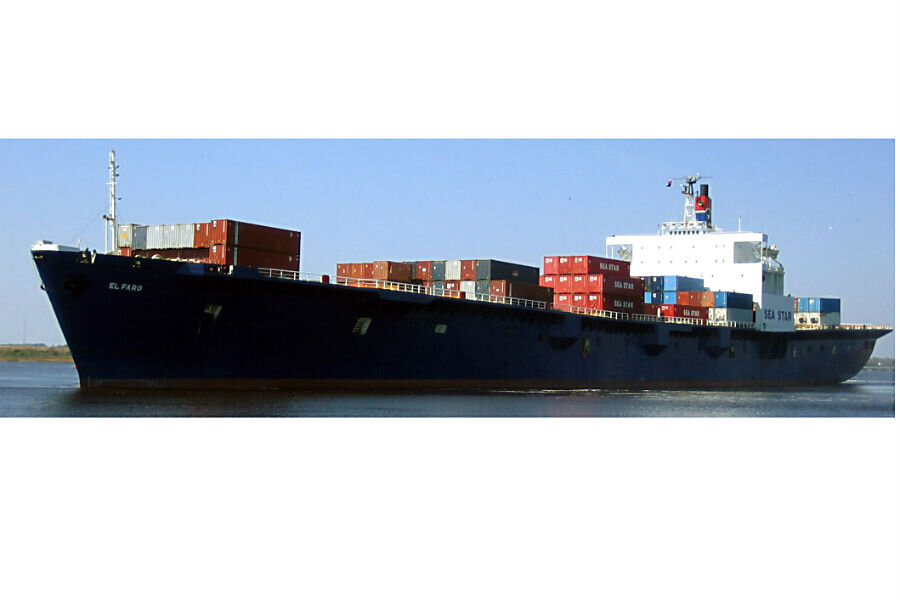El Faro found? Wreckage of cargo ship found 15,000 feet deep
Loading...
| Miami
Sonar indicates that the wreckage believed to be the cargo ship El Faro landed upright on the ocean floor, which may aid efforts to recover the ship's voyage data recorder, a National Transportation Safety Board spokesman said Sunday.
"The ship will certainly not be recovered; the ship is going to stay there. The containers are too deep to do any kind of recovery mission," said Peter Knudsen, NTSB spokesman. "If human remains are encountered, an attempt would be made to recover them."
Investigators are still awaiting video confirmation that the wreckage found Saturday in 15,000 feet of water east of the Bahamas is the El Faro, which went missing Oct. 1 during Hurricane Joaquin. All 33 crewmembers on board were lost.
"What they detected with sonar was about the size and shape of the El Faro," Knudsen said by telephone with The Associated Press.
"The target identified by Orion (side-scan radar) is consistent with a 790-foot cargo ship, which from sonar images appears to be in an upright position and in one piece," the NTSB said.
The NTSB said the USNS Apache crew located the wreckage at 1:36 pm ET during the fifth of 13 planned search line surveys.
The Navy, which has been searching for the El Faro since October 23, plans to send a remotely-operated vehicle named CURV 21 to investigate the wreckage on Sunday. The CURV 21 has video equipment that will help identify the vessel.
Once that is confirmed, a remotely operated, deep ocean vehicle called CURV-21 will use its video camera to document the wreckage and debris field, as well as attempt to locate and recover the data recorder — the ship's "black box." That recorder would have captured the crew's conversations on the bridge as well as information about the ship's equipment, including engine performance and rudder movements.
The recorder would be on deck near the 790-foot ship's wheelhouse area, and its recovery would be more challenging if the ship had landed upside down, Knudsen said.
"We do know the ship, from the sonar-generated images, does appear to be upright, so that's encouraging," he said.
The recovery operations could take up to 15 days, depending on weather and sea conditions.
The CURV-21 is designed to work up to a maximum depth of 20,000 feet of seawater, according to the Navy. The El Faro was reported missing east of the Bahamas, and it apparently came to rest at a depth greater than the final resting place of the Titanic, which lies over 12,500 feet down in the north Atlantic.
"It's very, very challenging at those depths. Imagine operating something under about two-and-a-half miles of water with underwater currents and total darkness. Then you have the weather at the surface to account for," said Jim Staples, a ship captain and maritime consultant based in Norwell, Massachusetts.
Investigators will be looking for any significant signs of damage or visible clues as to whether the crew had time deploy life rafts, he said.
"There may be a telltale sign like her back is broken or that she's split in half and that caused a quick sinking," Staples said.
The El Faro's captain called in before the vessel disappeared, saying the ship had lost its engine power during its voyage from Jacksonville, Florida, to San Juan, Puerto Rico. The captain, Michael Davidson, said the ship was listing, and taking on water.
An extensive Coast Guard search after the El Faro's disappearance found only floating debris and one body in a survival suit, which was not recovered.
The El Faro was scheduled for retirement from Caribbean duty and for new retrofitting for service between the West Coast and Alaska, company officials have said. Both the El Faro and its sister ship were slated to be replaced by two new ships. Aboard when it disappeared were five engineers from Poland, who were working on the retrofitting as the ship sailed to Puerto Rico.
NTSB investigators have said Davidson intended to pass 65 miles from the center of the storm — a risky decision, according to independent maritime experts.
___
Marcelo contributed to this report from Boston.







